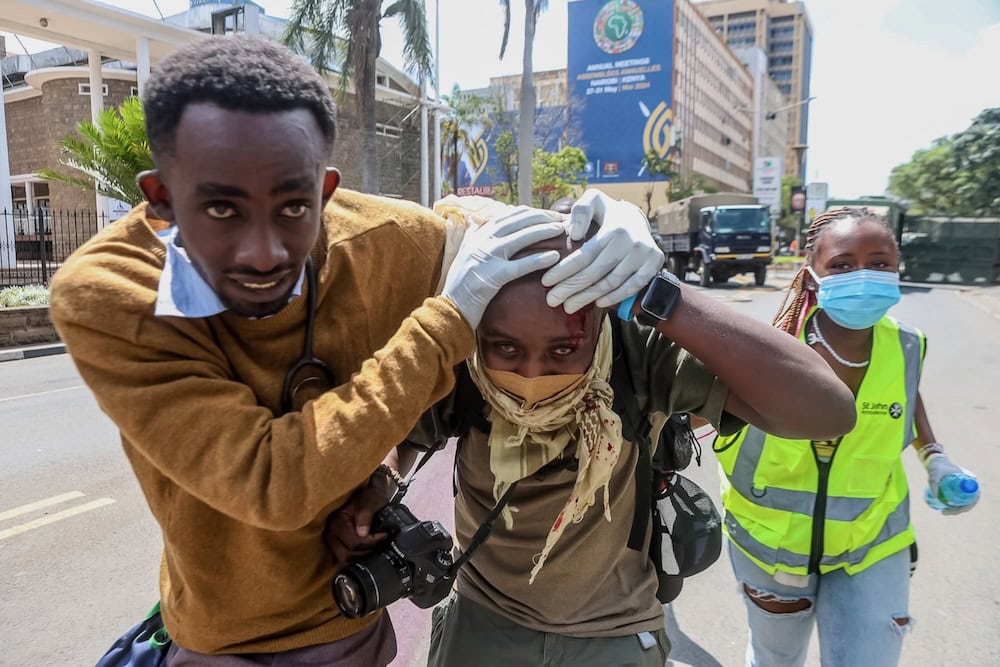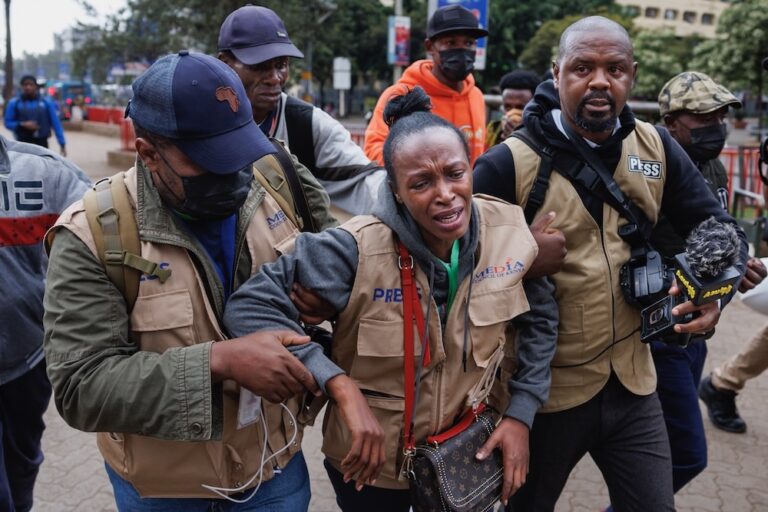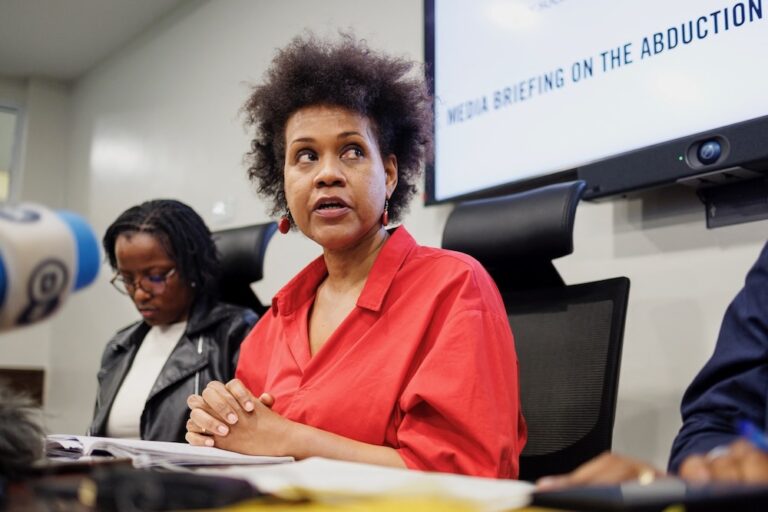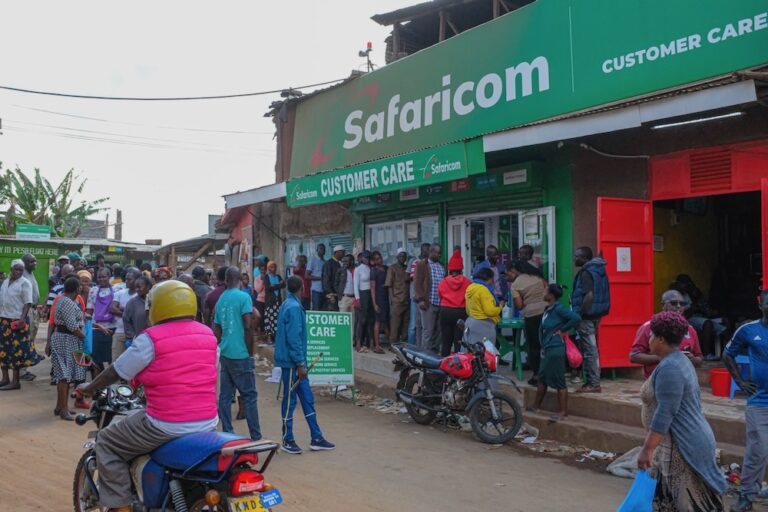The brutality inflicted by Kenya's police force, on journalists covering the anti-government protests, has been carried out with complete impunity.
This statement was originally published on rsf.org on 8 August 2024.
Rubber bullets, tear gas, arbitrary arrests, harassing victims… Reporters Without Borders (RSF) has documented seven weeks of police violence and intimidation against the Kenyan journalists covering the anti-government protests that are currently rocking the country. This brutality has been carried out with total impunity, and RSF has referred the matter to the authorities who oversee the Kenyan police.
The images of journalist Catherine Wanjeri Kariuki being shot by a police officer, then laying on the ground with a bloodied leg, leave no doubt about the gratuitous, deliberate nature of the rubber bullets that were fired in her direction. Clearly identifiable by her press jacket, Kariuki – a reporter for Kameme TV, Kenya’s first TV station in the country’s vernacular language – was filmed by fellow journalists amid clouds of tear gas during an anti-government protest on 16 July in Nakuru, a city northwest of the capital, Nairobi. “I know I was targeted as a journalist because I was right in the middle of a group of colleagues when they fired [them]. This policeman tried to kill me,” Kariuki, who was subsequently hospitalized, told RSF. The police officer who fired the rubber bullets from the back of a vehicle was filmed, yet two weeks after the shooting he remains to be officially identified and sanctioned.
Journalist Macharia Gaitho, who has also covered the protests, shares this certainty of having been targeted due to his work. A long-time reporter for the Daily Nation — the country’s most widely-read national daily — Gaitho was forcibly taken to the police station in the Karen district of Nairobi after being violently intercepted in his car on 17 July. Videos circulating on social media of Gaitho’s arrest show him being beaten by individuals in plainclothes and forced into an unmarked car. These individuals, who identified themselves as members of the Criminal Investigation Department (DCI), refused to show their identity papers. The journalist was eventually released, and the police announced it was “a case of mistaken identity” on X (formerly Twitter). This claim was disputed by Gaitho on the BBC, who highlighted the improbability of the alleged confusion with a man who shared his name, arguing, “I’m twice his age. He doesn’t live where I live […]. He doesn’t drive the same car I do.”
“During our investigation, we discovered that the Kenyan police had clearly perpetrated violence against journalists to prevent them from working, and issued threats to keep their blunders under wraps. The authorities’ failure to identify the perpetrators – despite instances where their acts of violence were caught on film – amounts to shameless impunity. The authorities must immediately put an end to these outrageous violent practices and the subsequent impunity. We have contacted the Kenyan police force and asked it to thoroughly investigate six cases of violence against journalists, to make their findings public, and to implement the appropriate sanctions against the perpetrators.”
Arnaud Froger, Head of RSF’s Investigation Desk
Several journalists have also been directly targeted by tear gas, such as Collins Olunga, a journalist for AFP, whose hand was injured on 15 June in Nairobi.” I can’t count the number of times that law enforcement have shouted at me not to film since the protests began. One policeman even threatened to take my phone if I continued to document what they were doing,” said Tom Mukhawana, an investigative journalist for Africa Uncensored who was also also targeted during the recent protests in the Kenyan capital on several occasions. His medical file, seen by RSF, documents bone lesions in his foot. “You become a target from the moment you record the abuses of law enforcement,” said Mukhawana, summarizing the anxiety felt by Kenyan journalists over the past few weeks.
Police intimidation of hospital patients
According to several witnesses, the police harassment continues post-violence. Videos of Kariuki’s admission to the Nakuru PGH Annex hospital, filmed by fellow journalists, show three individuals in civilian clothes posing as members of the criminal police and attempting to gain access to the journalist. The group of reports stepped in to stop the police, as they were already aware of this police tactic to collect the evidence of injury and attempt to control any information disseminated on the subject due to press articles on the subject.
The three men left, enraged, once the journalists blocked their access to the hospital, but not before sending a final message to Patrick Kinyua, founder of the online channel Nakuru TV, who was filming them. “The chief said to me in Swahili, ‘Wewe tunakujua,’ which means, ‘We know you.’ It clearly sounded like a threat.” According to Kinyua, there is no doubt that “their intention was clearly to cover up what their colleagues did to Catherine Wanjeri Kariuki.”
“Who knows what information I might have given them while I was suffering, which doesn’t allow you to think clearly, or what they might have done with the evidence,” said Kariuki when contacted by RSF after her release from the hospital.
Total impunity for the perpetrators
Despite the growing violence, none of the investigations allegedly carried out by the Independent Policing Oversight Authority (IPOA) have come to fruition. Statements from the Kenyan police force alternate between assuring thorough investigations and admitting that they’ve encountered problems. On 17 July, police spokesman John Waiganjo stated that he was working “under very difficult conditions,” and that he had “never experienced such a level of non-cooperation” from senior police officers since the structure was created.
On July 31, IPOA announced on its X account that it had interviewed witnesses concerning the cases of Kariuki and other targeted journalists. Nevertheless, two weeks after being wounded, Kariuki remains indignant: “I am not satisfied with the ongoing investigation. The shooting was filmed live, so how is it possible that the policeman has not yet been identified?”
At the time of this writing, the IPOA had not yet responded to RSF, who contacted the IPOA on 2 August 2024.
Kenya ranks 102nd place out of 180 countries in RSF’s 2024 World Press Freedom Index.



